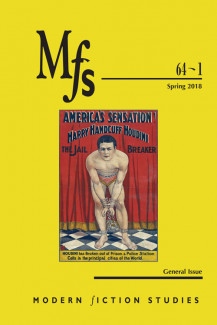
Johns Hopkins UniversityEst. 1876
America’s First Research University
No Escaping Houdini's Influence

Michael Chabon's Pulitzer Prize-winning novel The Amazing Adventures of Kavalier & Clay came out in 2000, but still resonates in literary circles nearly 20 years later. The Spring 2018 issue of MFS Modern Fiction Studies featured "The Politics of Escapistry:Harry Houdini, Nostalgia, and the Turn from Critique in Michael Chabon's The Amazing Adventures of Kavalier & Clay," by Iain Bernhoft, a Visiting Assistant Professor of English at Providence College. Bernhoft joined us to talk about his essay and the staying power of Chabon's work.
How did you come to develop this essay?

So the initial iteration of this essay was a sprawling, ungainly dissertation chapter. I was also much more critical of the novel’s escapistry at first. I read it as a sort of disavowal of economic and historical realities, with Houdini’s magic serving to paper over that which we would prefer not to confront as we go about consuming entertainment. Basically I climbed aboard my critical high horse, as one does… The essay became much stronger when I took Kavalier & Clay’s treatment of escapistry seriously on its own terms. One of the novel’s primary strengths is the way it explores the limitations of imaginative escapistry and of an ironic, critically detached viewpoint as well.
It took a while to get it to this finished state, and I am gratefully indebted to my dissertation readers—John T. Matthews and Rob Chodat—for helping me reconceive of it as a shorter, sharper intervention.
What does it say about Kavalier & Clay that it has this kind of critical relevance almost 20 years after publication?
Kavalier & Clay retains critical relevance, at root, because it offers an immersive reading experience which is both highly accessible and rich with literary depth. I think it’s also hands-down Michael Chabon’s best novel: he sometimes falls prey to indulging his own writerly powers to excess, but in Kavalier & Clay the flights of lyricism and fancy always serve the needs of the story.
It also retains critical relevance because a number of prominent tensions in contemporary discourse—between commercial entertainment and art, fleeing reality and confronting it, consumption and critique, irony and earnestness—are so deeply ingrained in the novel. Those tensions aren’t going away anytime soon, and Chabon gives us light by which to consider them closely.
What makes Houdini such a valuable tool for Chabon and so many other authors, filmmakers, etc.?
This was one of the questions I was trying to figure out as I looked at various ways Houdini pops up in contemporary culture. I really do think the figure of Houdini today indicates something about widely shared hopes or fantasies about what art can do or be. He represents a longing for release from the shackles of reality (as Chabon argues in Kavalier & Clay), but also reassurance that imaginative escape is OK, even salutary. As such, he offers a specific lens through which artists can think about the function of their art.
At the same time, I don’t think Houdini gets quite enough credit for how contemporary a figure he was: the way he used spectacle and irony, the way he worked with the media, and particularly the way he “developed his brand” (to use contemporary parlance)—all would play comfortably in the age of TV and Twitter. His career offers a window onto the origins and character of celebrity culture and the commodification of identity.
What makes MFS the right vehicle for this kind of essay?
In my essay, I aim to position a close reading of a contemporary work of fiction within a longer cultural history and a broader critical conversation. MFS has published quite a few similarly-oriented essays that I really admire, so in revising this essay I sought to emulate the journal’s general approach. I am excited to have my work published there!


